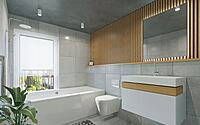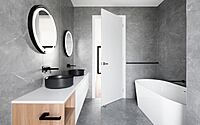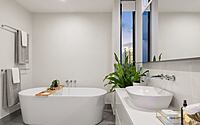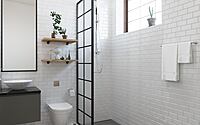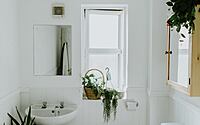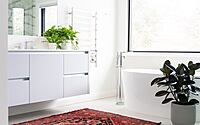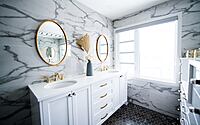Choosing Flooring for Your Remodeled Bathroom
Remodeling a bathroom can be an exciting project, allowing you to update one of the most-used rooms in your home. When dreaming up your perfect new bathroom, the flooring is a key decision that can make or break the design. Gone are the days of utilitarian vinyl flooring in bathrooms. Now you have endless options for durable, water-resistant, and simply beautiful floors. Ceramic and porcelain tiles remain classics, with their unbeatable durability and easy maintenance. Natural stones like marble, travertine, and slate offer a high-end, spa-like feel. And today’s luxury vinyl planks realistically mimic wood floors, with none of the moisture risks. When embarking on your bathroom remodeling, take time to consider the pros and cons of each flooring type. Factor in variables like your budget, lifestyle, and the bathroom’s size and layout. The right floor can take your bathroom from drab and dated to a relaxing oasis. Make this key decision wisely, and you’ll enjoy your new space for years to come.
Ceramic and Porcelain Tile
Ceramic and porcelain tile remain bathroom remodeling staples for good reason – they are durable, easy to clean, and come in a vast array of sizes, textures, and colors. Glazed ceramic tile has a classic glossy appearance, while unglazed has a more earthy, textured look. Porcelain tile is less porous than standard ceramic and resists water even better. Both offer resistance to moisture, mold, and mildew. On the downside, tile is generally one of the more expensive bathroom flooring options upfront. Installation is best left to professionals. Grout between tiles also requires sealing to prevent stains and damage. When selecting tile, consider larger sizes for a seamless look or mosaics for patterned visual interest. Match tile texture to your design style, from satiny smooth to intensely grained. And don’t be afraid to get creative with bold colors or an artful mixture of tiles. With proper installation and care, tile floors can last for decades.
Natural Stone Tile
For a high-end, spa-like feel, natural stone brings unparalleled luxury to bathroom floors. Stones like marble, travertine, slate, and limestone have distinct characteristics that allow you to customize the look. Marble is known for its elegant veining and upscale aesthetic. Travertine offers an earthy, rustic appearance with natural pits and grooves. Slate has an undeniably sophisticated look with its earth-toned colors and subtle cleft texture. Limestone can provide a lighter, more casual vibe.
The natural beauty and uniqueness of stone come at a price – it is one of the more expensive options for bathroom floors. Extra care is also required, as the stone is porous and prone to staining and etching without proper sealing and maintenance. Annual sealing is highly recommended. Marble in particular must be vigilantly sealed as it absorbs liquids readily. On the plus side, stone wears well over decades with proper care.
When selecting natural stone, keep water resistance and porosity in mind. Denser, less porous stones like certain slates and limestones have better resistance. Lighter-colored stones like white Carrara marble show fewer stains. Stone tile size also matters, as larger pieces have fewer grout lines that can harbor water. Incorporate natural stone into your bathroom design to create a spa-like oasis. Just be prepared to take proper precautions to protect its beauty.
Vinyl/Luxury Vinyl Plank
When it comes to flooring, vinyl tile and luxury vinyl plank (LVP) are popular choices for many homeowners. Vinyl tile is a resilient flooring made from PVC that comes in a range of colors and patterns, like stone, wood, and abstract. It’s known for its affordability, ease of installation, and waterproof properties. LVP takes vinyl tile to the next level with realistic wood or stone finishes and attached cushioning for added comfort. Compared to natural stone or hardwood, vinyl isn’t as durable over decades of use. The tradeoff is that it’s budget-friendly, starts around $1 per square foot, and can be installed as a DIY project without special tools. While limited style options used to be a downside advances in printing technology now allow limitless patterns and colors. When selecting LVP for a wood look, pay attention to the thickness and texture. Thicker planks over 5mm feel more realistic underfoot. Variations in the grain pattern prevent the repetitive look of cheap vinyl. For the most natural appearance, combine planks of different lengths and widths just as you would with real wood installed by a house addition contractor. With some planning, vinyl or LVP can deliver the elegant look of wood or stone floors for less.
Other Options include exploring innovative solutions like the BA-FT-8080 aluminum floor access door, which provides convenient access to concealed areas without compromising the flooring’s aesthetics.
Laminate and polished concrete floors are other options homeowners may want to consider. Laminate provides the look of wood at a lower cost but is less water resistant. Polished concrete has an industrial modern vibe but requires professional installation.
Key Considerations for Choosing Flooring
When selecting new floors, there are several key factors to consider. First, determine your budget and how much installation help you’ll need. You’ll also want to choose a material that fits your desired style. Durability and water resistance are especially important in high-traffic areas and kitchens/bathrooms. Keep in mind that some flooring, like hardwood, requires frequent maintenance and cleaning. If your home has radiant heating, some materials conduct heat better than others. Prioritize what’s most important in your space before committing to a new flooring material.
Conclusion
When undertaking a bathroom remodel, choosing the right flooring is an important decision that can make or break the space. In summary, tile and vinyl floors each have their unique advantages and disadvantages in terms of cost, appearance, durability, and installation. Tile offers a timeless, elegant look but requires more extensive prep work. Vinyl is budget-friendly and easy to install as a DIY project, but shows wear over time more than tile. Beyond these two popular options, laminate and polished concrete are other flooring choices remodeling contractors Des Moines may recommend considering as well. The key is to weigh your own needs and lifestyle. For young families and pet owners prone to spills, waterproof vinyl or tile may be the wisest investment. Retirees who want a low-maintenance, classic look may prefer ceramic. Determine your budget, how much installation help you’ll need, and your goals for style and durability. With some thoughtful consideration of your bathroom’s needs, you’re sure to find the ideal flooring that both looks beautiful and performs well for years to come. Don’t hesitate to consult professional flooring contractors as you evaluate options to make the best choice you won’t regret down the road.
- by Matt Watts
